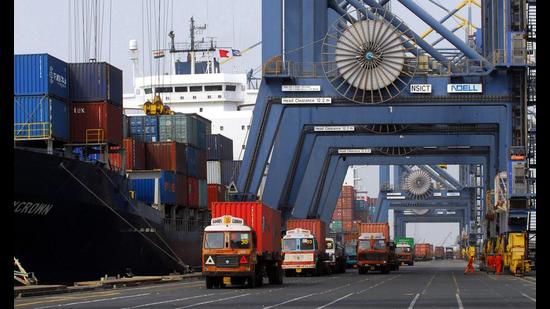India must find its way back into trade arrangements
 PREMIUM
PREMIUM
India and its neighbours have been hesitant to embrace trade as a core element in development. India’s decision to opt out of the Regional Comprehensive Economic Partnership (RCEP) is but one example. No one who knows South Asia is surprised that it continues to be the most protected as well as the least-integrated region in the world.
As India watches, Southeast Asian countries are signing free trade agreements (FTAs), improving market access and creating conditions for deepening their already strong integration with global value chains. Some of these trade initiatives include the Comprehensive and Progressive Agreement for Trans-Pacific Partnership (CPTPP) covering Pacific-rim countries; RCEP, which includes the Association of Southeast Nations (Asean) plus five countries; Vietnam’s FTAs with the European Union and the United Kingdom (UK), and Singapore’s FTA with the European Union (EU), China has also recently applied for membership of CPTPP.
These initiatives impact India and other South Asian countries by affecting relative incentives for trade and investment.
In Southeast Asia, Vietnam has been the most agile. The European Union-Vietnam FTA (EVFTA), which came into force on August 1, 2020, exerts pressure on India in apparel, leather goods, footwear and fisheries. Vietnam’s spurt in manufacturing and exports, arising from increases in productivity, proximity to regional shipping routes, and lower wages (vis-à-vis China), coupled with lower or even zero tariffs that it already enjoys in Southeast Asia and will perhaps now enjoy in the EU and the UK market, could squeeze traditional as well as future Indian exports of pharmaceuticals, information and communication technology (ICT) goods and electronics in these markets. Moreover, the Vietnam-UK FTA, which came into force on May 1, will increase competition in the UK for goods and services exports from India, Bangladesh and Pakistan.
These developments mean that Vietnam is likely to attract additional European foreign direct investment (FDI) in manufacturing and services to improve access to the huge RCEP market. The same incentive will also push other RCEP countries to invest in Vietnam to improve European market access. Since India does not enjoy the same level of trade preferences as Vietnam, it stands to lose some investment from European and RCEP countries. Even nimble Indian firms are likely to look out for new investment opportunities in Vietnam, to improve market access in RCEP, EU and CPTPP countries.
Across the seas, the renegotiated US-Mexico-Canada Trade Agreement (USMCA) has rewritten trade rules that may also affect South Asian countries. It redefines the existing supply chains in the automobile sector by raising the use of locally-manufactured components and labour to qualify for tariff exemptions. This may impact India’s position in the automobile value chain, reflected in exports of motorcar parts and accessories as well as steel and aluminium products. Other provisions in the USMCA strengthen the rules of origin in the textile industry that could potentially hurt apparel/textile exports from South Asia, including Bangladesh.
However, new openings are also emerging. Rising wage costs in China as well as the US-China trade war present new opportunities to attract American, Japanese, South Korean and even Chinese firms that are relocating away from China. Globally, firms want to rely less on China, and Covid-19 has accelerated this tendency. India has an opportunity to attract some of these relocating firms, which will also help boost its trade.
Global trade could also shift over the next decade in response to changes in technology and carbon emission/renewable energy commitments, as well as the efforts of Western countries to secure robust supply chains in some critical products such as semiconductors and pharmaceuticals.
How can India address the ongoing changes in trading relationships as well as broader changes in the global landscape? Instead of being reactive, it could be more proactive and forward-looking, such as in building economic alliances that leverage the links between trade and investment. For example, a bilateral India-UK FTA could help India negotiate better terms in goods and services, including movement of professionals, and in attracting FDI from the UK. There is scope for greater collaboration in science, research and development (R&D) and Fintech. Given that FTAs are a matter of give and take, India should be prepared for greater concessions in areas of interest to the UK.
India will also benefit from considering the economic interests of its South Asian neighbours, who have been bystanders in these global realignments. India can take advantage of new openings to enhance its cross-border economic relationships. It can encourage trade and creation of regional value chains by investing in neighbouring countries to enhance their export capacity and competitiveness, accompanied by an increase in cross-border imports. It can also encourage FDI from neighbours, including Bangladeshi FDI to India’s Northeast. The creation of such regional value chains can also create more possibilities for India’s neighbours to benefit from the new trade and investment partnerships that India is considering.
Sanjay Kathuria is a senior visiting fellow, Centre for Policy Research, and teaches at Ashoka and Georgetown Universities. TG Srinivasan is a senior visiting fellow, Centre for Policy Research. Prachi Agarwal is a senior research officer, Overseas Development Institute.
The article is based on their report : Playing Catch-Up: Looming Trade Questions for India and South Asia
The views expressed are personal
Enjoy unlimited digital access with HT Premium
